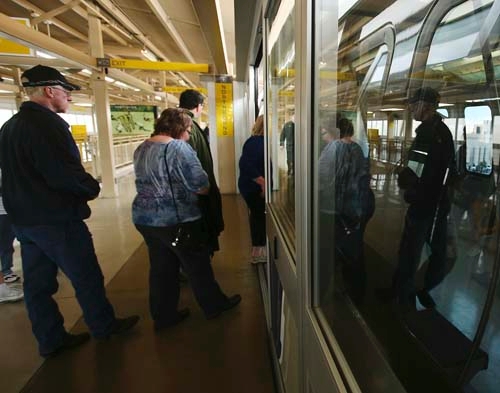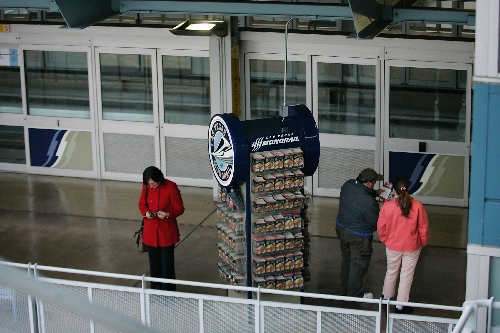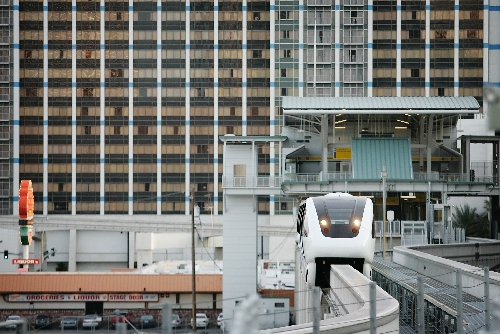Passengers find flaws with Las Vegas Monorail





The escalator lurches and thumps, sounding much like a washing machine thrown off balance by a too-large load.
Halfway up, Adam Chen, a tourist from Arizona, wonders, "If this is the ride to the monorail, what will the ride be like on the monorail?"
Chen, who was in town recently for a convention, took the lumbering escalator up from the Sahara’s monorail entrance to the station platform. He had already used the monorail twice and, while he found it convenient, he also found it lacking.
"It’s too expensive. I’ve used real mass transit systems in other cities and none of them cost this much," Chen says, lamenting the $12 cost for an all-day pass. "And they need to spend some money on fixing up a few things."
Such as the escalator. It functions, but its noisy lurching could leave would-be riders with the impression that all is not well with the Las Vegas Monorail. And though it runs daily along its 3.9 mile route just east of the Strip, there are telltale signs that suggest the monorail’s ills extend well beyond a spastic escalator.
The once highly touted and anticipated rail system that was supposed to ferry millions of tourists and locals up and down the Strip filed for bankruptcy in 2010. Revenue was $23.3 million in 2010. Ridership hit 5.2 million people last year, far less than the 20-plus million annual riders monorail advocates envisioned during its early days. About 2 percent of riders are local.
The stations are orderly and the trains clean, says George Georgeff, a local who has used the monorail to commute to work for the past year. It’s dependable, with trains arriving every six to nine minutes for either the northbound or southbound routes. Still, they could do a lot more for riders, especially locals, he says.
"Overall, I think it’s a good thing," he says. "But you can only purchase (locals) tickets at either the Sahara or at MGM (Grand) stations. It’s inconvenient, and I have to go out of my way to get them."
The customer service booth, the only place where riders can interact with a monorail employee, is closed on this recent Wednesday. A sign hanging on the booth shows that someone will be "back at 3:35." That’s more than half an hour away. Georgeff stands and waits for it to open.
The automated ticket dispensers sell only the regularly priced tickets, so he can’t use that: $5 for a one-way trip, $12 for an all-day pass and $28 for a three-day pass. A machine where passengers can redeem tickets purchased online is out of order.
The Sahara station is dead. A few people trickle past Georgeff, some leaving and others arriving. Weekends are the busiest times, he says.
Tickets for locals with identification cost $1 each, but there is a maximum of two per day, says Ingrid Reisman, monorail spokeswoman. In the past, they could be purchased in bundles of 20 if a local wanted to travel to the RTC’s downtown location where they were sold. That deal is no longer offered.
"They need to offer like a 30-day pass for locals," Georgeff says. "I know they’re probably worried about resale, but it’s a chance they have to take."
The ticket limit is imposed to cut down on fraud, Reisman says, adding that monorail officials don’t like to discuss that possibility because, "we don’t want to put it in people’s heads who haven’t already thought about it."
Georgeff says he can understand why people get frustrated with the monorail, especially when they’re trying to find it. Several signs along the Strip make it seem as though the monorail is right around the corner. In reality, a platform can be a 10- or 15-minute walk away.
John and Maria, a California couple who declined to give their last name, were exasperated on this recent Wednesday. And they were only halfway to the MGM Grand platform. As the end of the line and near the busy intersection of Las Vegas Boulevard and Tropicana Avenue, the MGM platform is the most crowded on this day.
"We were asking ourselves if we should just walk to the Paris," Maria says. "The signs said the monorail was this way, but I had no idea it was so far away."
Georgeff, whose job is to help set up convention halls, is grateful that the monorail exists. He can walk from his apartment to the Las Vegas Convention Center station and be at work within half an hour.
The ride itself is a bit bumpy, with train cars rocking back and forth, but the temperature is warm and comfortable on this windy day. Cheesy elevator music plays over the speaker system, interrupted only by the computerized voice announcing each stop.
The view is not scenic. While resorts invest so much time and money into putting on the perfect facade, the monorail takes it away when it travels past dumpsters, empty lots with broken asphalt, wires and utility poles, the back of several casinos.
The stations are orderly and clean, but most are not crowded, at least by Las Vegas standards. At the Convention Center stop, a few conventiongoers trickle on with some getting off. Sometimes, it hardly seems like people use the monorail, Georgeff says. Still, he adds, it’s a good thing to have a mass transit system and should get even better if someone spent some money and time on it.
"There is value in the monorail," he says.
FAST FACTS
The monorail runs 7 a.m. to 2 a.m. Mondays through Thursdays, and 7 a.m. to 3 a.m. Fridays through Sundays . Stations are at MGM Grand, Bally’s, Paris Las Vegas, Flamingo Las Vegas, Harrah’s Las Vegas, Las Vegas Convention Center, Las Vegas Hilton and Sahara.
Ticket prices:
Nevada residents: $1 with a two-ticket maximum per day (tickets are available only at the Sahara and MGM Grand stations, and only from customer service booths manned from 11 a.m. to 6 p.m.)
$5 for one-way trip
$12 for all-day pass
$28 for three-day pass
For more information, visit lvmonorail.com or call customer service at 699-8200.
Contact reporter Sonya Padgett at spadgett@reviewjournal.com or 702-380-4564.
FAST FACTSThe monorail runs 7 a.m. to 2 a.m. Mondays through Thursdays, and 7 a.m. to 3 a.m. Fridays through Sundays . Stations are at MGM Grand, Bally’s, Paris Las Vegas, Flamingo Las Vegas, Harrah’s Las Vegas, Las Vegas Convention Center, Las Vegas Hilton and Sahara.
Ticket prices:
Nevada residents: $1 with a two-ticket maximum per day (tickets are available only at the Sahara and MGM Grand stations, and only from customer service booths manned from 11 a.m. to 6 p.m.)
$5 for one-way trip
$12 for all-day pass
$28 for three-day pass
For more information, visit lvmonorail.com or call customer service at 699-8200.












